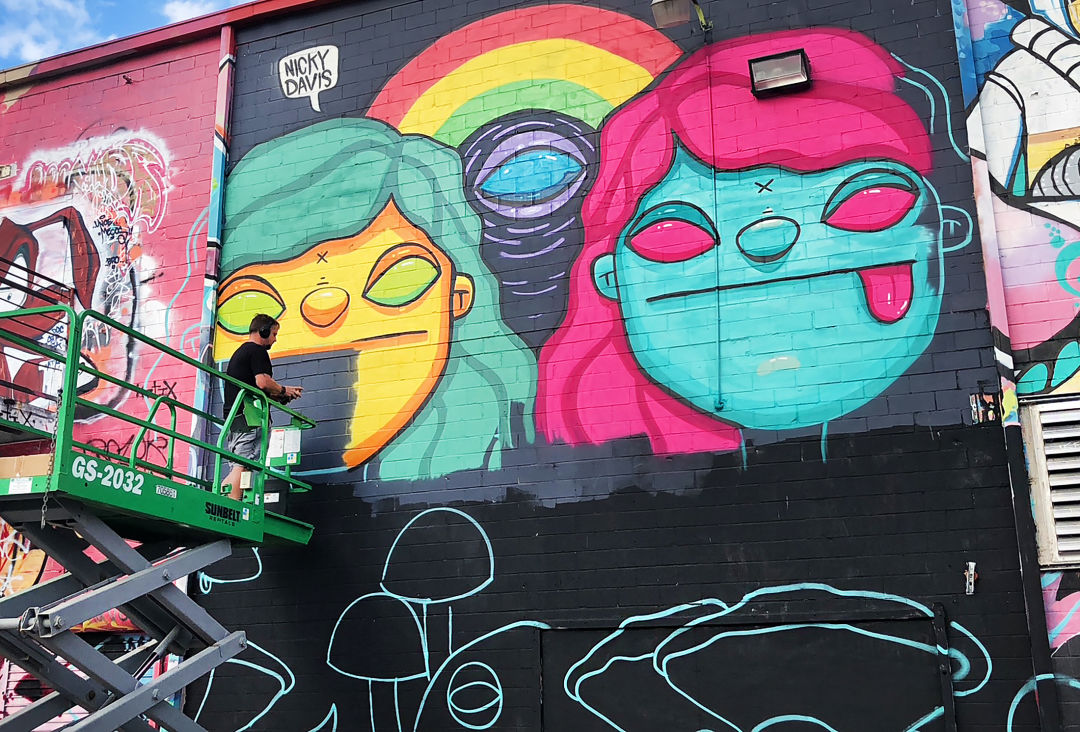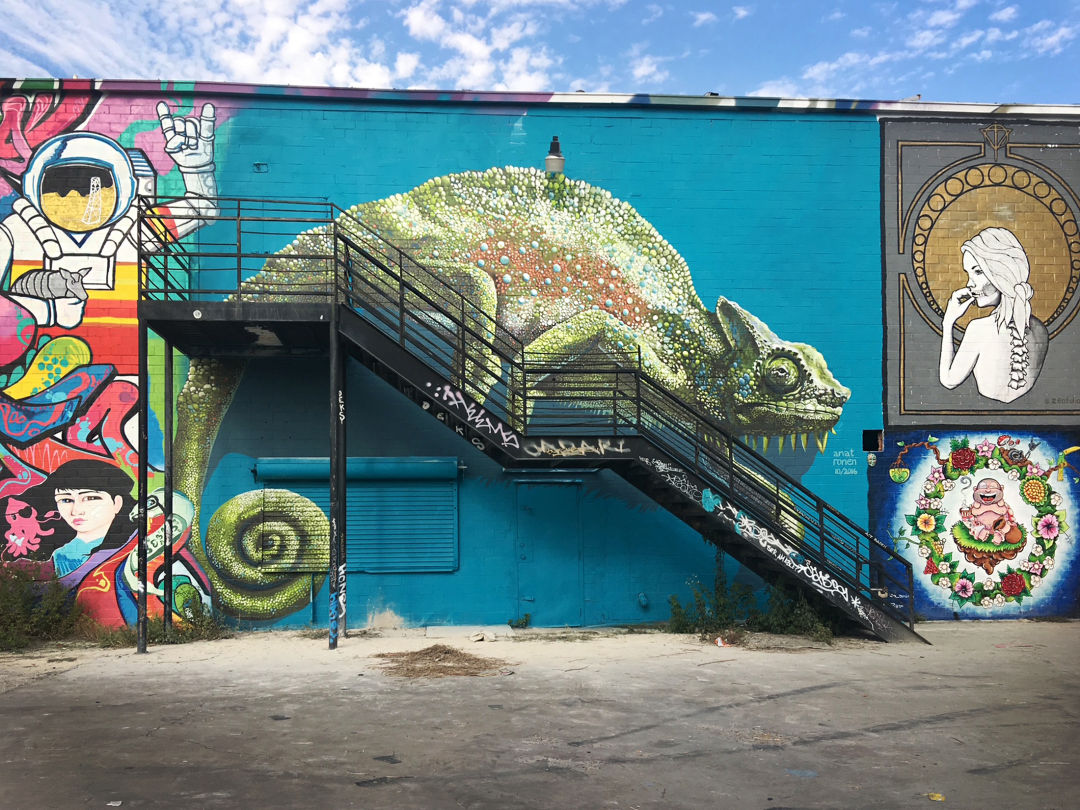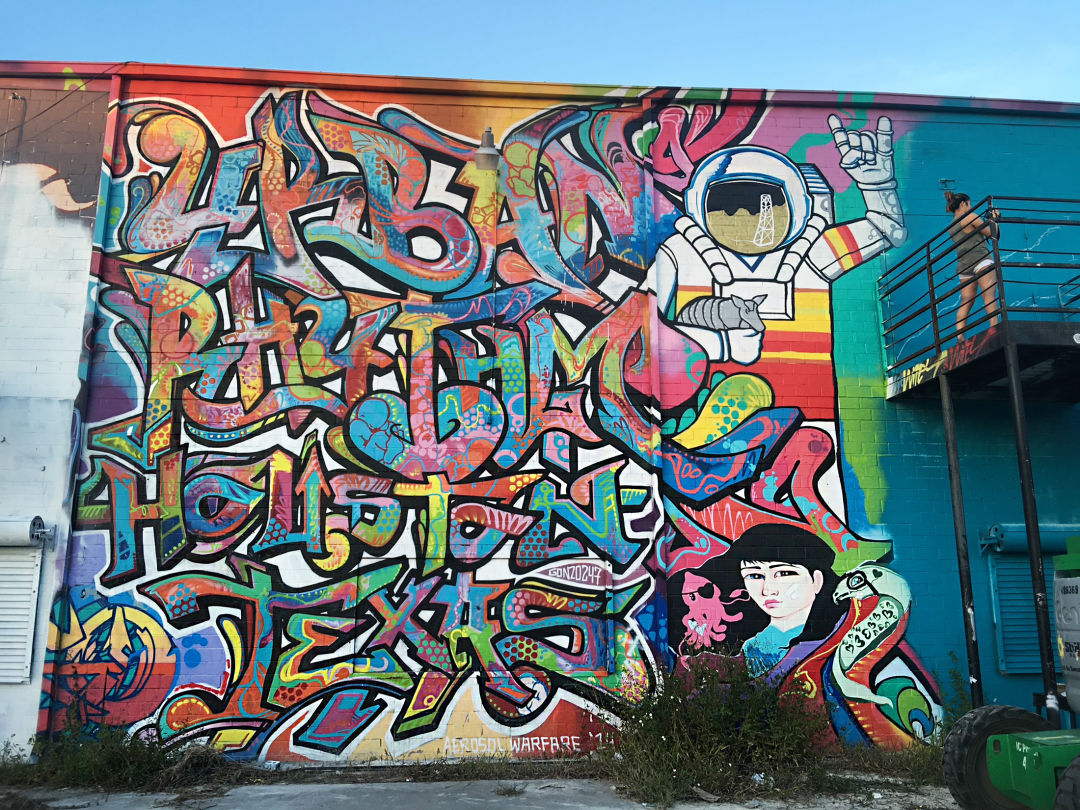Murals like GONZO247’s Houston piece had been a draw for vacationers and locals alike.
Graffiti Park, a welcoming Houston landmark treasured by native artists, was lowered to rubble on June 18, 2025, after demolition crews ready for the growth of Interstate 45, a yearslong Texas Division of Transportation-backed mission that has led to the closure of eating places and companies throughout East Downtown. Nonetheless, the graffiti haven’s legacy lives on, and what began as a music venue comprising three buildings has been witness to an exquisite evolution, present first as a short-lived meals truck park; then, as a beloved canvas for the town’s avenue artwork group.
For greater than a decade, Graffiti Park was the beating coronary heart of Houston’s avenue artwork scene. Anchored at Chartres and Leeland streets, blocks away from Downtown’s skyline, the social media–well-known hangout was an explosion of coloration and creativity, with questionable legality. Whether or not or not the murals had been thought of public artwork or unlawful vandalism was a murky dialog, however that by no means actually stopped anybody. Followers would flock there day by day to see murals displayed on its internationally acknowledged partitions. There was paintings by hometown heroes like GONZO247, Article, and DECK WGF, vibrant tributes to native legends just like the hip-hop icons Underground Kingz (UGK) and Tejano music queen Selena Quintanilla, and shifting memorials to Kobe Bryant and George Floyd. It was additionally a prized stage for group occasions, together with Pink Bull’s BMX pageant City Rhythm and a 2023 episode of the Hulu streaming sequence Drive with Swizz Beatz.

Photos of the now-demolished murals reside on in our social media archives.
Born within the East Downtown neighborhood, extensively often known as EaDo, Graffiti Park originated as a part of the town’s industrial district and the historic Previous Chinatown that after stretched from Leeland to Saint Emanuel streets. In accordance with Preservation Houston consultant Jim Parsons, not a lot is understood concerning the constructing’s historical past or when it was constructed—simply that the area was an amalgamation of three industrial buildings, and its homeowners and landlords, who’ve modified arms a few instances, reworked the area into completely completely different venues. “Architecturally, they weren’t something exceptional,” Parsons says of the plot of nondescript buildings; they had been positioned in what was basically a wasteland of deserted warehouses close to Downtown, he provides.
Graffiti Park’s story really begins with former nightclub and music venue, the Meridian. Native graffiti pioneer GONZO247, formally often known as Mario Figueroa, Jr., says the area was “meant for inventive expression.” He recollects frequenting the Meridian, the place he would hang around with DJs, musicians, and fellow graffiti artists, resembling Article, also called Phillip Orlando Perez. “We had an artwork studio proper there within the center [of Old Chinatown], and we’d stroll round tagging up the warehouses, and Graffiti Park was one among them,” Perez says.

Native artist Nicky Davis paints in his signature cartoon-like model.
By the early 2000s, the Meridian constructing had turn into a hub for each underground hip-hop followers and artists: Perez helped convey the hip-hop pageant, then often known as B-Boy Hoedown, to life, rallying collectively graffiti artists, breakdancers, and hip-hop followers to the center of Houston. Nevertheless, after years of internet hosting concert events and music occasions, the Meridian introduced its abrupt closure on December 21, 2010, with the Houston Press reporting allegations of a administration shakeup and months of unpaid hire. After its closure, the area was in for one more section. In the summertime of 2013, the constructing reopened because the Houston Meals Park, an area that welcomed meals vehicles and hip-hop classic outlets, based on Perez, Figueroa, and Houston historian James Glassman. Nonetheless, creators converged on the area with cans of spray paint and artwork provides in hand, reworking it into an open-air gallery.

Practically each wall of 1503 Chartres St was lined in murals.
Landlords on the meals truck park ultimately reached out to artists to curate an official assortment. Graffiti Park pioneer and avenue artist Daniel Anguilu led the cost, bringing in additional creatives and permanentish items to the multiuse area. Shortly after, Perez says the meals truck park closed, however the murals and rising artwork group stayed. Murals and tags started masking the constructing’s clean partitions, and by November 2013, information of the rising Graffiti Park had unfold. Pink Bull even caught wind of the area and debuted its City Rhythm occasion there, which mixed the thrills of avenue artwork and BMX. “Your entire aspect [of the Graffiti Park] received became this in a single day pop-up BMX, dust bike, superior factor with graffiti, and it was wonderful,” Figueroa says. The park gained much more momentum. “It pushed quite a lot of artists to begin portray. Then, each constructing wished a mural. It was contagious.”

The park was a central location for graffiti artists and muralists to collect.
In time, avenue artwork like Perez’s signature tag—woodgrain textured 3D letters with the phrases “Houston Kings” in purple— stuffed the partitions of almost each empty spot on the park partitions. Artists like Lee the One Lee (actual identify: Lee Washington) and late artist Gerard Moran, finest often known as DECK WGF, turned common contributors, with Moran usually hanging out on the park day by day, incomes his dwelling by displaying his artwork on the market among the many murals, Perez and Figueroa say. On the park’s partitions had been black-and-white bubble letters of his identify, standing out amongst colourful tags. Comparable works, Perez mentioned, are present in random tunnels throughout Houston, if the place to look. Extra mainstream artworks by DECK included a larger-than-life portrait of a Black girl with an afro sporting an off-the-shoulder prime. The caption learn: “Embracing your true self radiates a pure magnificence that can not be diluted or ignored!”

The late DECK WGF’s signatures had been splattered throughout Graffiti Park.
Because the park’s fame grew via phrase of mouth, so did its influence on Houston. Graffiti Park had no set hours, no entrance price, and no gatekeepers. It turned a uncommon sanctuary for experimentation and creative expression, a spot the place skilled and beginner artists, in addition to admirers, armed with nothing however paint and creativeness, may create, day or night time. “We ended up in deserted buildings as a result of that’s what was accessible to us. Graffiti Park was stunning as a result of it was centrally positioned…[and] an equal distance to everybody. Nobody owns Downtown. No person owns this space, so it was welcoming to folks from throughout the town,” Figueroa mentioned. “It’s a loss that speaks volumes.”

Guests had been certain to see murals splayed on almost each wall.
In late June, demolition crews from the transportation division started tearing down the favored, albeit unofficial, Houston establishment. For the primary time in Graffiti Park’s 12-year historical past, fences had been put up round its exterior. Artists and curious viewers had been not allowed close to the buildings, and delightful murals had been lowered to grey rubble. Even the final remaining works from DECK WGF weren’t protected from bulldozers.
Officers erased the final little bit of Moran’s life from the town, a very robust blow to the artist group that was nonetheless mourning Moran’s loss of life in September 2024, after he handed away from a blood clot. “We’ll by no means see one other DECK piece once more, particularly [with] his scale and his dedication to create,” Figuero says. “That died with him.”
In an effort to salvage park mementos and items of DECK’s remaining work, artists tried to attend the demolition. Each Figueroa and Perez say they had been turned away by armed safety guards, who alleged that the whole lot on-site, together with trash and rubble, was the only real property of TXDOT. A consultant for the transportation division defined in an electronic mail to Houstonia that demolition areas are lively work websites secured for security causes. “Security is all the time prime precedence,” the consultant wrote. “Furthermore, we wish to remind the group that something positioned on the demolished construction was by no means sanctioned, commissioned nor formally permitted.” Whether or not thought of official or not, the murals artwork nonetheless meant one thing to the town. So, after the demolition, within the stillness of the night time, Figueroa returned to the park, hopped the fence, and liberated three bricks from a dusty pile of particles.

All that is left of Graffiti Park is three bricks salvaged by Figueroa.
Now, Graffiti Park is survived by the artists who gave it life and is preceded in loss of life by Deck WGK, whose work as soon as lined its partitions. Uniquely Houston, the park lives on endlessly in Houstonians’ reminiscences and social media archives. Nevertheless, lots of the metropolis’s artists declare that the native graffiti group has nowhere to show. TXDOT has promised to contribute a mitigation fund of as much as $500,000 to public artwork initiatives in EaDo; representatives defined that they might defer to EaDo’s Tax Increment Reinvestment Zone (TIRZ) for updates. However the group nonetheless grieves. Native artists are uncertain about the place graffiti aficionados will go subsequent.
Figueroa says he hopes to revamp his studio area and in style Wall of Fame graffiti cease in its place, providing group areas like a museum devoted to Houston graffiti and artwork lessons to fill the void. Perez says neighborhoods like his house base in North Central Houston and Third Ward’s Mission Row Homes are welcoming to new artists, however Graffiti Park’s central location within the metropolis was a part of its attraction. None, he says, have the attraction or fame of their predecessor.

